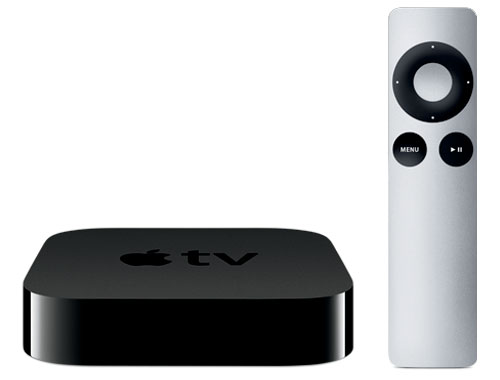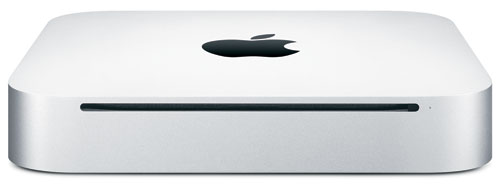Hosted by site sponsor WebMate.
Apple TV Q&A
Published October 7, 2010
Also see: All Apple Q&As >> Apple TV Q&A (Home)
To be notified of new Q&As, sign up for EveryMac.com's bimonthly email list.
What are the differences between the Apple TV 2nd Gen and the Aluminum Mac mini available at the time of its introduction?
Please note that these models have been discontinued. However, this Q&A can be quite helpful for anyone considering either model on the used market.
When EveryMac.com compared the original Apple TV to the polycarbonate Mac mini models available at the time of its release, the two systems looked fairly similar and had some common elements but were quite different in functionality.
For the black second generation Apple TV compared to the consumer-focused aluminum Mac mini available at the time of its release -- the Mac mini "Core 2 Duo" 2.4 (Mid-2010) -- it is immediately clear that these systems have little in common in design, specifications, or functionality.
In a nutshell, the second generation Apple TV is designed to make it simple to stream content to a HDMI-equipped HDTV and rent movies and television shows from Apple. The aluminum Mac mini, on the other hand, is a full fledged computer and is capable of performing the full gamut of tasks that an entry-level Mac can perform. Not only is it easy to connect an aluminum Mac mini to an HDMI-equipped HDTV, it also is easy to play DVD movies, listen to music with iTunes, surf the Internet, write documents, create websites, organize photos, play games, and more.
The Mac mini is much more powerful as well as capable. The second generation Apple TV supports 720p video playback whereas the aluminum Mac mini supports full 1080p. The aluminum Mac mini also can be used to store content and the second generation Apple TV cannot.
Those interested in the shortest answer can stop reading and make a decision based on the above. However, because both models are easy to connect to a television -- and there are so many differences -- an in-depth comparison also can be useful for those interested in all the details.
Externally, the black second generation Apple TV is quite different from the aluminum Mac mini. The black second generation Apple TV is housed in a truly tiny 3.9 inch by 3.9 inch by 0.9 inch case in black that resembles a hockey puck and ships with an aluminum Apple Remote.

Photo Credit: Apple, Inc. (2nd Generation Apple TV)
The aluminum Mac mini, by contrast, uses a relatively large 7.7 inch by 7.7 inch by 1.4 inch aluminum case. It does not ship with a remote by default, but it does support a remote and an aluminum Apple Remote can be added as a US$19 option.

Photo Credit: Apple, Inc. (Aluminum Mac mini)
Connectivity is different as well as external design. Both models have an HDMI port and support optical audio out and 802.11a/b/g/n "AirPort Extreme" wireless networking. However, the aluminum Mac mini models also have a Mini DisplayPort -- capable of passing an audio signal as well as video -- for simultaneous support of dual displays, a "Gigabit" Ethernet port, a Firewire "800" port, four USB 2.0 ports, support for analog audio out as well as optical/analog audio in and Bluetooth 2.1+EDR in addition to an SDXC capable SD card slot.
The second generation Apple TV does, however, have a lesser 10/100Base-T Ethernet port and a Micro-USB port "for service and diagnostics" (and hacking, no doubt). Power consumption is considerably different as well, as the the second generation Apple TV only uses 6 watts whereas the aluminum Mac mini uses 85 watts.
Although visually differentiation is simple based on material, color and size, should it be useful in the future, the second generation Apple TV uses model number A1378 and the "Mid-2010" aluminum Mac mini uses model number A1347. Both are listed on the bottom of each respective device.
Internally, the differences between models are perhaps even more substantial than the external differences.
The second generation Apple TV internally essentially is a fourth generation iPod touch without the display. Like its predecessor, Apple officially only notes the processor type -- an Apple A4 -- but iFixit tore apart the second generation model and discovered more details. Just as it is for the iPod touch 4th Gen, the Apple A4 processor in the second generation Apple TV has a maximum clockspeed of 1 GHz and it commonly runs around 750 MHz to 800 MHz. The second generation Apple TV has integrated graphics and 256 MB of onboard RAM, and although it officially has no internal storage, it has 8 GB of flash RAM to act as a buffer during streaming. It is all but certain that this 8 GB of flash RAM will be used by creative hackers for storage as well.
The aluminum Mac mini models -- specifically the Mac mini "Core 2 Duo" 2.4 (Mid-2010) -- is powered by a 2.4 GHz Intel "Core 2 Duo" (P8600) processor, a NVIDIA GeForce 320M graphics processor that shares 256 MB of RAM with the system, support for a maximum of 8 GB of 1066 MHz PC3-8500 DDR3 SDRAM, and a 320 GB hard drive for internal storage.
The operating system used by each model is completely different. The second generation Apple TV runs a variant of the iOS that powers the iPod touch and iPhone models, but it does not formally run the iOS nor can it run iOS applications either. The aluminum Mac mini runs the full version of Mac OS X 10.6 "Snow Leopard" (and higher) and can run all Mac OS X applications that are compatible with "Snow Leopard" including applications that can record television with additional hardware.
These differences are summarized below for your convenience:
 2nd Gen Apple TV |
 Mid-2010 Mac mini |
|
|---|---|---|
| Processor Type: | Apple A4 | Core 2 Duo (P8600) |
| Processor Speed: | 1 GHz* | 2.4 GHz |
| Standard RAM: | 256 MB | 2 GB |
| Standard VRAM: | Integrated | 256 MB† |
| Video Type: | Integrated | GeForce 320M† |
| Hard Drive: | None | 320 GB |
| Flash Memory: | 8 GB** | None |
| Optical Drive: | None | 8X DL "SuperDrive" |
| USB Ports: | 1 (Micro-USB) | 4 (2.0) |
| Firewire Ports: | None | 1 (800) |
| Display Ports: | HDMI | HDMI, Mini DisplayPort†† |
| Audio Ports: | Optical | Optical, Analog |
| SD Card: | No | Yes (SDXC) |
| Ethernet Support: | 10/100Base-T | Gigabit |
| AirPort Support: | 802.11a/b/g/n | 802.11a/b/g/n |
| Bluetooth Support: | No | 2.1+EDR |
| OS Support: | iOS Derived | Mac OS X 10.6 |
| Video Support: | 720p | 1080p |
| Sync Required: | No | No |
| Stream Content: | Yes | Yes |
| Store Content: | No | Yes |
| Recording Capability: | No | Yes (3rd Party Software) |
| Dimensions (In): | 3.9" x 3.9" x 0.9" | 7.7" x 7.7" x 1.4" |
| Power Consumption: | 6 Watts | 85 Watts |
| Remote Included: | Yes | No |
| Case Material: | Polycarbonate | Aluminum |
| Case Color: | Black | Silver |
| Apple Order No: | MC572LL/A | MC270LL/A |
| Apple Model No: | A1378 | A1347 |
| EMC No: | 2411 | 2364 |
| Original Price: | US$99 | US$699 |
* This processor has a maximum clockspeed of 1 GHz and it commonly runs around 750 MHz to 800 MHz.
** The second generation Apple TV has 8 GB of flash RAM to act as a buffer during streaming. It is not designed for use as storage.
† The NVIDIA GeForce 320M graphics processor is "integrated" and shares a minimum of 256 MB of RAM with the system for video function.
†† The Mini DisplayPort on the "Mid-2010" Mac mini is capable of passing an audio signal as well as a video signal.
So, which is best for my needs?
Ultimately, only you can decide if the second generation Apple TV or an aluminum Mac mini is best for your needs. If you need a simple and relatively inexpensive way to stream iTunes content from a Mac or PC (or your iPod touch, iPhone or iPad) to your HDTV as well as stream Netflix, YouTube, Flickr and MobileMe content, and/or are interested in renting -- but not buying -- content from Apple, the second generation Apple TV could be ideal.
If you would prefer a full fledged "media center" to connect to your television -- complete with support for CD/DVD playback, support for practically unlimited file formats (with third-party software), and the option of both buying content from Apple and recording television content, the ability to store content locally, and do everything else a Mac can do -- an aluminum Mac mini is a great choice provided that it is within your budget.
Also see: What are the differences between the black second generation Apple TV and the original Apple TV? Which one is best for me?
Permalink | Report an Error/Typo | Sign Up for Site Update Notices
Established in 1996, EveryMac.com has been created by experts with decades of experience with Apple hardware. EveryMac.com includes, and always has included, original research incorporating detailed, hands-on inspection of packaging, computers, and devices as well as extensive real-world use. All information is provided in good faith, but no website or person is perfect. Accordingly, EveryMac.com is provided "as is" without warranty of any kind whatsoever. EveryMac.com, and the authors thereof, shall not be held responsible or liable, under any circumstances, for any damages resulting from the use or inability to use the information within. For complete disclaimer and copyright information please read and understand the Terms of Use and the Privacy Policy before using EveryMac.com. Copying, scraping, or use of any content without expressed permission is not allowed, although links to any page are welcomed and appreciated.
